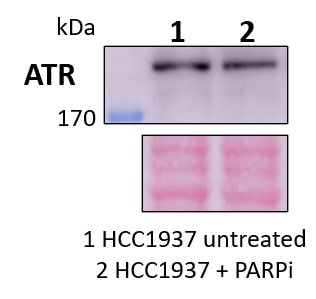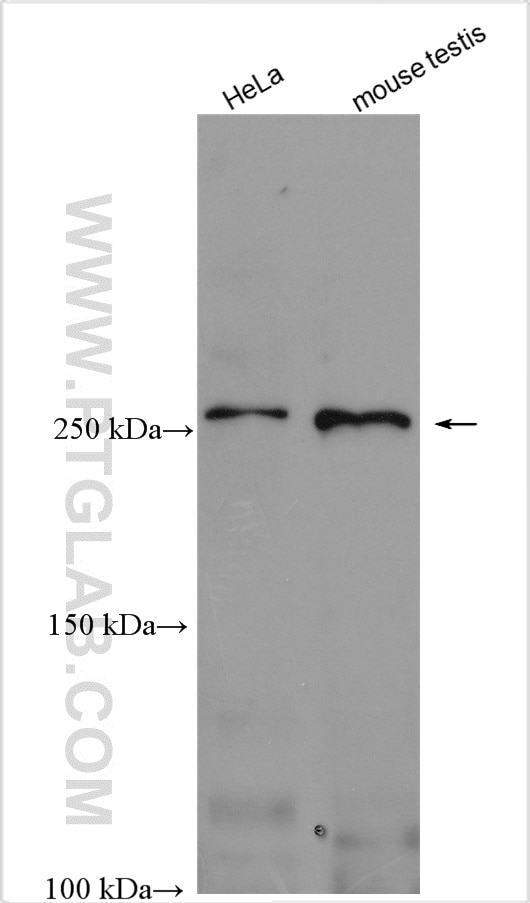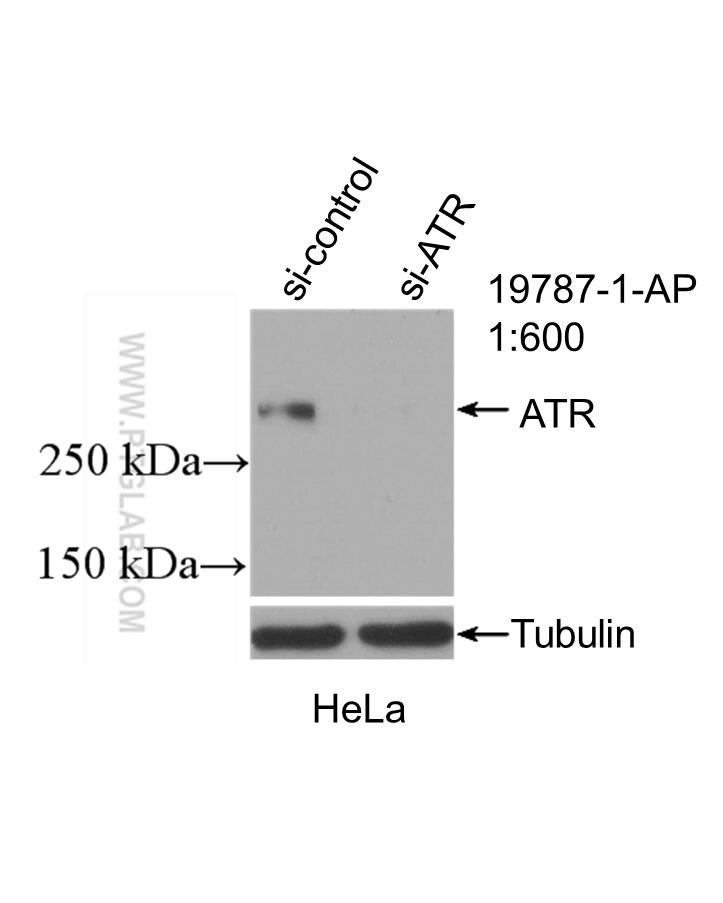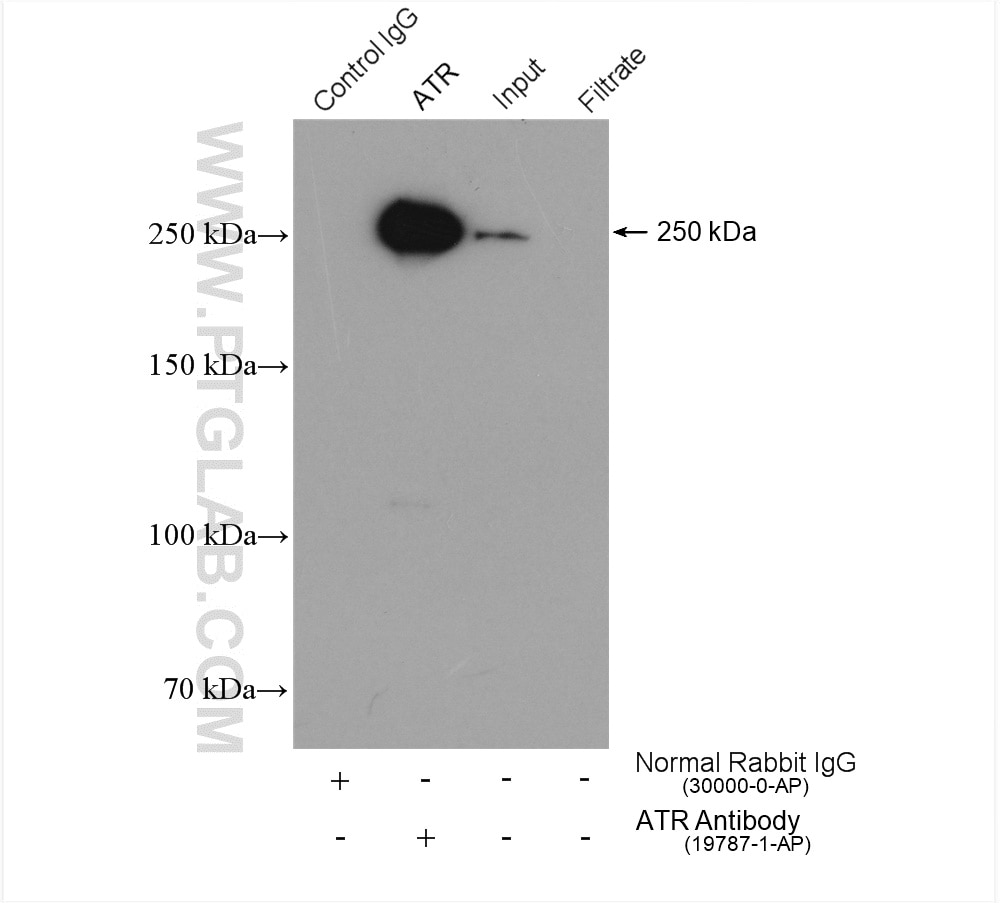- Phare
- Validé par KD/KO
Anticorps Polyclonal de lapin anti-ATR
ATR Polyclonal Antibody for WB, IP, ELISA
Hôte / Isotype
Lapin / IgG
Réactivité testée
Humain, souris et plus (1)
Applications
WB, IP, IHC, CoIP, ELISA
Conjugaison
Non conjugué
N° de cat : 19787-1-AP
Synonymes
Galerie de données de validation
Applications testées
| Résultats positifs en WB | cellules HeLa, tissu testiculaire de souris |
| Résultats positifs en IP | tissu testiculaire de souris, |
Dilution recommandée
| Application | Dilution |
|---|---|
| Western Blot (WB) | WB : 1:500-1:1000 |
| Immunoprécipitation (IP) | IP : 0.5-4.0 ug for 1.0-3.0 mg of total protein lysate |
| It is recommended that this reagent should be titrated in each testing system to obtain optimal results. | |
| Sample-dependent, check data in validation data gallery | |
Applications publiées
| WB | See 30 publications below |
| IHC | See 4 publications below |
| CoIP | See 1 publications below |
Informations sur le produit
19787-1-AP cible ATR dans les applications de WB, IP, IHC, CoIP, ELISA et montre une réactivité avec des échantillons Humain, souris
| Réactivité | Humain, souris |
| Réactivité citée | rat, Humain, souris |
| Hôte / Isotype | Lapin / IgG |
| Clonalité | Polyclonal |
| Type | Anticorps |
| Immunogène | Peptide |
| Nom complet | ataxia telangiectasia and Rad3 related |
| Masse moléculaire calculée | 301 kDa |
| Poids moléculaire observé | 250-290 kDa |
| Numéro d’acquisition GenBank | NM_001184 |
| Symbole du gène | ATR |
| Identification du gène (NCBI) | 545 |
| Conjugaison | Non conjugué |
| Forme | Liquide |
| Méthode de purification | Purification par affinité contre l'antigène |
| Tampon de stockage | PBS avec azoture de sodium à 0,02 % et glycérol à 50 % pH 7,3 |
| Conditions de stockage | Stocker à -20°C. Stable pendant un an après l'expédition. L'aliquotage n'est pas nécessaire pour le stockage à -20oC Les 20ul contiennent 0,1% de BSA. |
Informations générales
ATR, also named as FRP1, belongs to the PI3/PI4-kinase family and ATM subfamily. ATR is a serine/threonine protein kinase which activates checkpoint signaling upon genotoxic stresses such as ionizing radiation (IR), ultraviolet light (UV), or DNA replication stalling, thereby acting as a DNA damage sensor. ATR recognizes the substrate consensus sequence [ST]-Q. ATR phosphorylates BRCA1, CHEK1, MCM2, RAD17, RPA2, SMC1 and TP53/p53, which collectively inhibit DNA replication and mitosis and promote DNA repair, recombination and apoptosis. ATR phosphorylates 'Ser-139' of histone variant H2AX/H2AFX at sites of DNA damage, thereby regulating DNA damage response mechanism. It is required for FANCD2 ubiquitination. It is critical for maintenance of fragile site stability and efficient regulation of centrosome duplication. ATR catalyze the reaction: ATP + a protein = ADP + a phosphoprotein. Defects in ATR are a cause of Seckel syndrome type 1 (SCKL1) which is a rare autosomal recessive disorder characterized by growth retardation, microcephaly with mental retardation, and a characteristic 'bird-headed' facial appearance. The antibody can recognize all the isoforms of ATR.
Protocole
| Product Specific Protocols | |
|---|---|
| WB protocol for ATR antibody 19787-1-AP | Download protocol |
| IP protocol for ATR antibody 19787-1-AP | Download protocol |
| Standard Protocols | |
|---|---|
| Click here to view our Standard Protocols |
Publications
| Species | Application | Title |
|---|---|---|
Cell Res DNA damage triggers tubular endoplasmic reticulum extension to promote apoptosis by facilitating ER-mitochondria signaling. | ||
ACS Nano Graphene Oxide Causes Disordered Zonation Due to Differential Intralobular Localization in the Liver. | ||
Nat Commun ATR/Chk1 signaling induces autophagy through sumoylated RhoB-mediated lysosomal translocation of TSC2 after DNA damage. | ||
Cancer Res Combined inactivation of CTPS1 and ATR is synthetically lethal to MYC-overexpressing cancer cells. | ||
Oncogene Antifungal agent Terbinafine restrains tumor growth in preclinical models of hepatocellular carcinoma via AMPK-mTOR axis. | ||
J Cell Mol Med Potent USP10/13 antagonist spautin-1 suppresses melanoma growth via ROS-mediated DNA damage and exhibits synergy with cisplatin. |
Avis
The reviews below have been submitted by verified Proteintech customers who received an incentive forproviding their feedback.
FH Priya (Verified Customer) (01-17-2023) | I have used this antibody for human keratinocytes, cardiomyocytes, mouse skin and liver tissues
|
FH Marina (Verified Customer) (06-26-2022) | HCC1937 human breast cancer cells untreated (1) and treated with a PARP inhibitor (2). Primary antibody was incubated at 4ºC overnight in rotation. A single band >170 kDa could be observed in both conditions. Ponceau staining was used as total protein loading control.
 |
FH WEI (Verified Customer) (03-08-2022) | Good target band with backgrouds
|




